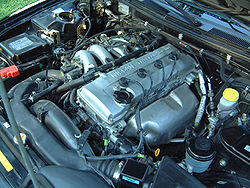This article relies largely or entirely on a single source .(November 2018) |
| Nissan KA engine | |
|---|---|
 | |
| Overview | |
| Manufacturer | Nissan (Nissan Machinery) |
| Production | 1988–2021 |
| Layout | |
| Configuration | Naturally aspirated Inline-4 |
| Displacement |
|
| Cylinder bore |
|
| Piston stroke |
|
| Cylinder block material | Cast iron |
| Cylinder head material | Aluminum |
| Valvetrain | SOHC 2- or 3 valves x cyl. (1988-1997) DOHC 4 valves x cyl. (1991-2016) |
| Compression ratio | 8.6:1, 9.1:1, 9.2:1, 9.5:1 |
| Combustion | |
| Fuel system | Sequential electronic FI |
| Management | Hitachi |
| Fuel type | Gasoline |
| Cooling system | Water-cooled |
| Output | |
| Power output | 134 hp (100 kW) (1988-1996) 155 hp (116 kW) (1996-2004) 143 hp (107 kW) (1998-2004 Frontier & Xterra) |
| Torque output | 152 lb⋅ft (206 N⋅m) at 4400 rpm (1988-1996) 160 lb⋅ft (217 N⋅m) at 4400 rpm (1996-2004) |
| Chronology | |
| Predecessor | Nissan Z engine |
| Successor | Nissan QR engine |
The KA engines were a series of four-stroke inline-four gasoline piston engines manufactured by Nissan , which were offered in 2.0 and 2.4 L. The engines blocks were made of cast-iron, while the cylinder heads were made of aluminum.
Contents
Despite their large capacity, this motor was not equipped with balance shafts.
When used in the passenger cars both versions of the KA24 used a crankshaft girdle, as opposed to individual main bearing caps. In the Nissan Hardbody and Frontier applications a crank girdle was not used.
